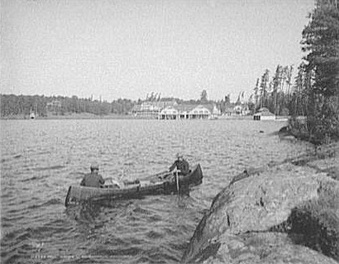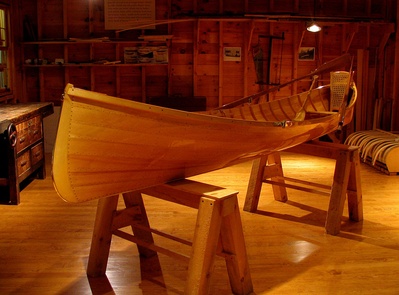 Guide boat, Lower St. Regis Lake, Paul Smith's Hotel in background, 1903
Guide boat, Lower St. Regis Lake, Paul Smith's Hotel in background, 1903  This boat was built at the Adirondack Museum" as a boat-building demonstration.
This boat was built at the Adirondack Museum" as a boat-building demonstration.
Adirondack guideboats were built since the early 1800s and evolved from a hunting skiff to today's highly refined design, virtually unchanged since the late 1800s. The Adirondack guideboat was originally designed to benefit the professional sporting guide who carried the boat and provided all the propulsion for his paying passengers, who were hunters or fishermen who travelled to the Adirondack region of upstate New York from New York City.
It was in the guides' best interest to make their craft both lightweight and easy to carry over the typically unimproved roads and trails between the lakes and streams of the Adirondack region. While the boat is known as the fastest fixed seat rowing boat, the stability of the Adirondack Guideboat has often been described as merely adequate for the sporting purposes (hunting and fishing) for which they were originally built. The New York craft were famous for their on-center tenderness, a trade-off from their remarkable speed.
Although these boats resemble canoes, they are not. They are built in the same manner as a skiff and rowed, not paddled, except for short distances with a "sneak" paddle. The boat is more stable than a canoe because the occupants are sitting lower, almost on the bottom of the boat. The oars are pinned and aligned so that if the rower stops rowing and lets go of the oars they will stay with the boat and trail behind such that they do not change the direction of the boat. Adirondack guideboats have won open water rowing races in some very challenging conditions.
Modern reproduction Adirondack guideboat hulls are made of kevlar, fiberglass or wood strips. Some hulls use both materials, with a wood hull and a fiberglass laminate applied to the outer surface for greater durability. The boat can be fitted with either a fixed or a sliding seat and outriggers for racing.
Since 1962 the annual Willard Hanmer Guideboat & Canoe Race has been held in July in Saranac; it is a ten-mile canoe and kayak race on Lake Flower and down the Saranac River. Willard Hanmer was a master guideboat builder. There is also a Guideboat class in the Adirondack Canoe Classic, the three day 90-Miler from Old Forge to Saranac Lake.
The Adirondack Museum has several classic examples in its collection. 1
There is a guideboat in the Saranac Lake Free Library, and one at the Adirondack Medical Center.
New York Times, July 12, 1908
ADIRONDACK BOATS CRANKY.
Easiest Thing in the World to Get a Ducking, if You Are Not Careful.
Special to The New York Times.
SARANAC INN, N. Y., July 11—The Adirondack guide boat, a craft especially adapted to the Adirondack lakes and streams, is a cranky boat and soon instills the mind of the unwary with a wholesome respect for itself. In the hands of an experienced oarsman it rides the water gracefully and easily, but to the beginner it is often for a time full of terrors, for any attempt at acrobatic feats usually result in a good ducking before the unfortunate has had time to realize what Is happening.
Miss B. J. Carwell of New York, who Is spending the season at the Inn, was the victim of an unfortunate upset In front of the Casino. While attempting to leave the dock the young woman made a false move and in an instant was plunged into the water. Mr. Searle, who happened to be near, came to the rescue and assisted her from the perilous position. Miss Carwell, however, was undaunted and has since proved that the accident was not due to inexperience, for she is one of the best and most enthusiastic oarswomen at the Inn...
See also:
Sources
- Durant, Kenneth, Helen van Dongen Durant, The Adirondack Guide-Boat, 1980, International Marine Publishing, ISBN 9780877421252.
External links
- Chris Woodward's boat shop
- Adirondack guideboat information
- Adirondack guideboat manufacturer
- Plans & photos from the Adirondack Museum
Comments
Footnotes
1. This article appeared originally on "Wikipedia" as Adirondack guideboat"; its edit history there reflects its authorship. It is licensed under the GDFL.



